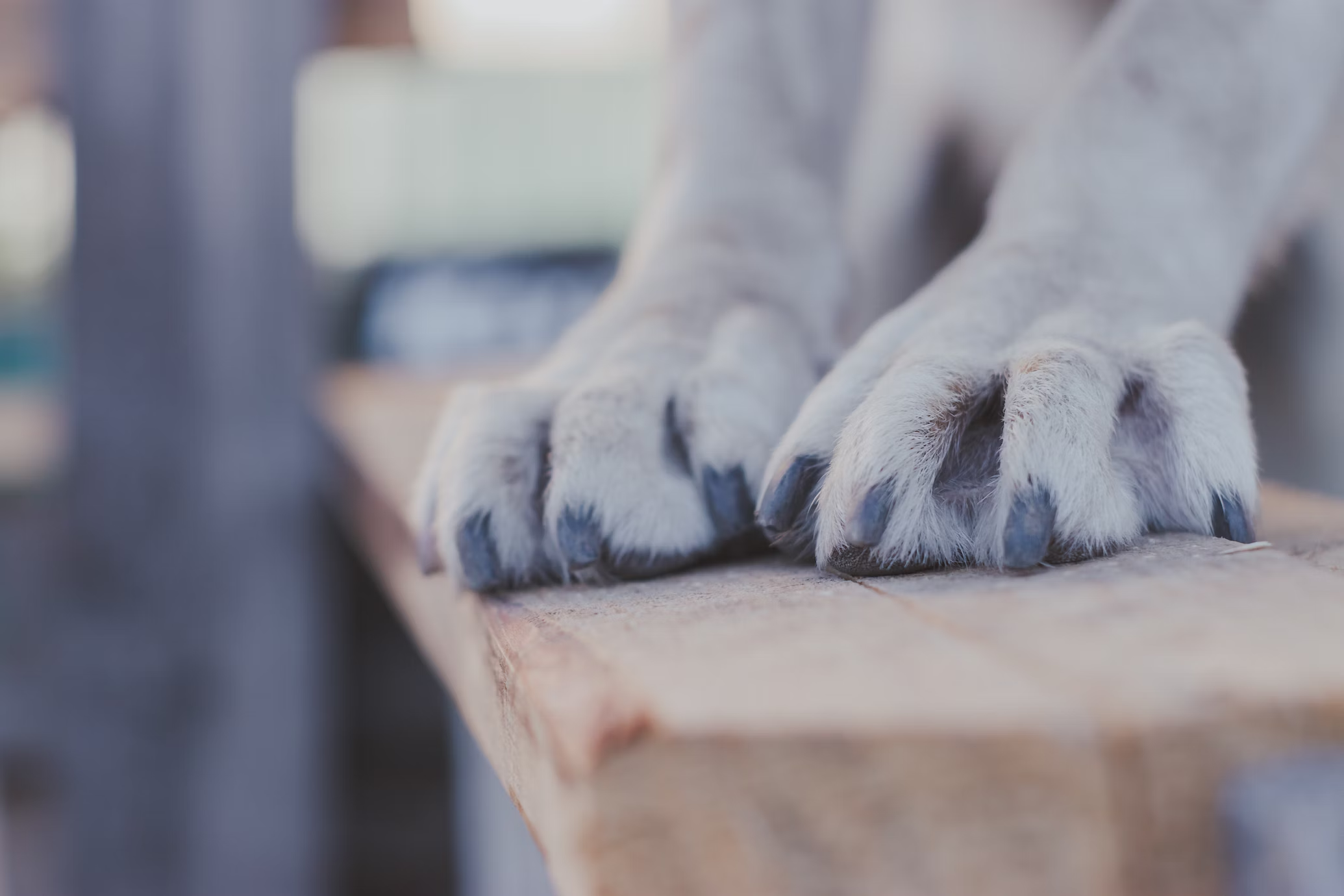You glance down noticing your pup’s paws look bright pink instead of their usual color. Should this harmless pigment change raise concern about their health or merely natural variations in canine skin and fur? Understanding common causes explains when blushing paws reflect problematic pathology versus innocuous norms requiring no intervention.
Let’s explore reasons behind pink, red or inflamed dog paws deciphering what’s behind their colorful revelation and interpreting necessary next steps guaranteeing their comfort long term.
Common Causes of Pink Dog Paws
Most dogs sport pink paws perfectly normally at times due to:
Pigmentation Genetics
- Like people boasting fair complexions including rosy faces/knees, many dogs naturally showcase light fur and skin tones prone revealing capillaries and blood flow nearest surfaces. Pink paws correlate their overall pigmentation lacking dense layers obscuring vascular views nearer skin. Dogs with thin white, spotted or pink fur frequently display rosy feet correspondingly. Genetic breeds like French bulldogs and pit bulls also reveal pink pawslinked color dilution traits not pathology inherently.
Environment Staining
- Grass chemicals, outdoor terrain like clay mud or gravel abrasions, winter deicers and sidewalk hot spot residue can temporarily dye fur pinkish on contact. These external irritants wash away restoring normal tones without lasting skin damage.
Post Washing/Grooming
- Hot water baths or shampoo contact leaves freshly scrubbed skin pink for hours until circulation calms. Similar flushing occurs after nail trims or hair clipping sessions simply from handling stimulating blood flow to paws. Like human skin irritation, mild post-grooming pooch pinking subsides.
Healing Skin Injury
- Mild abrasions, cracked paw pads and irritated areas glow pink signaling vascular activity vital transporting repair components developing new skin layers mending external insults over time. Monitor for complications, but pastel paws from healing reflect positive progress, not pending perilnecessarily.
When pink resides solely paws absent wider illness symptoms, relax knowing genetic pigment variations, temporary irritants or active healing cycles explain harmless changes typically fading independent eventual normal paw shade restoration.

Concerning Causes of Pink Dog Paws
While pink paws frequently follow benign scenarios above, several more problematic potential causes needing veterinary diagnosis and care include:
Allergies
Environmental or food allergies manifesting itchy, raw, reddened feet and inflamed skin characterizing overall reactions. May involve swelling, hair loss and secondary infections also. Symptoms often affect paws, belly, ears and armpits first.
Burn Injuries
Severe burns from hot pavement, camp fires or household chemical spills damage skin cell layers initially showing redness losing protective fur layers next. Skin blisters/peels severely needing intensive wound care preventing lasting deformity.
yeeast Infections
Opportunistic yeast overgrowth between paw pads or nail beds shows redness and warm, wet swelling including cottage cheese like discharge strong smelling potentially.
Licking/Chewing Irritation
Allergy related incessant feet licking/chewing creates hives, self trauma removing fur exposing hugely inflamed pink skin vulnerable to secondary surface infection risks.
Parasites
Surface mites called mange especially impact lower limbs first causing severely irritated skin and crusty fur loss growing progressively without treatment.
Pemphigus Foliaceus Autoimmune Disease
This immune disorder attacks skin cell connections sloughing paw skin layers initially before progressing over the entire body without medication intervention.
Proper diagnosis and management from your family veterinarian provides needed symptom relief restoring comfortable quality of life when problematic reddened paws emerge. Don’t ignore subtle early clues something systemic brews below the surface.

Seeing the Vet About Pink Dog Paws
Schedule prompt veterinary evaluation if your dog develops tender, raw red paws showing swelling, skin changes or lameness concerning beyond briefly post grooming/activity flushing mentions before.
What to Watch For
Monitor how long pinkness persists beyond 48 hours and whether painful symptoms accompany skin changes like discharge, odor or licking suggesting infection risk. Note if swelling and overall lethargy worsens rapidly indicating urgent injury or if symmetrical areas over weeks slowly expand relationships with primary illness factors.
Questions Your Vet May Ask
- When did you first notice their feet looking pink?
- Does pinkness resolve then return consistently?
- Have you changed any feeding, walking terrain or household products lately?
- Is your dog generally chewing/licking their paws more frequently?
- Do they show other symptoms like appetite/activity changes lately?
By answering thoroughly tracking symptom timelines and contexts, your veterinarian and you partner determining likely root causes guiding next diagnostics and treatments whether topical solutions or addressing systemic diseases restore lasting paw comfort. Don’t settle simply masking irregular pinkness without pursuing explanations and relief your pup deserves.
Treatment Options
Diagnostic testing like skin scrapings, blood panels and eliminating allergy triggers guides specific therapeutic plans which may include:
- Allergy desensitization shots
- Antibiotics/antifungals treating secondary infections
- Steroids/antihistamines reducing immune related swelling
- Diet trials pinpointing food triggers
- Topical ointments/pads protecting cracked skin
- Preventative paw wax/booties shielding from environmental irritants
Follow all veterinary home care instructions diligently giving remedies time reaching full therapeutic effects. Book follow up rechecks ensuring proper healing progression or medication adjustments if initial attempts prove inadequate calming recurrence. Persistence pays off restoring lasting comfort.

Preventing Recurring Pink Dog Paws
Once current pink paw flares subside through vet recommended management, build in preventatives avoiding repeat episodes:
- Wipe paws clean post walks protecting pillow time avoided licking residue off themselves.
- Invest in paw balm moisturizing cracked pads.
- Upgrade food brands reducing filler risks irritating allergy prone pups.
- Rinse off lawn chemicals contacting feet romping through treated grass.
- Place booties during winter months shielding feet from salt exposure.
While some dogs will simply always showcase rosy feet as part of their individual vibrant pigmentation, pay attention to changes breathing easier once sinister causes ruled out pursuing proactive solutions keeping them comfortable long term.
The Bottom Line
Generally pink paws prove perfectly normal variation across dogdom flashing temporary irritation, healing or genetic breed correlates. However, persistently inflamed, painful or spreading skin changes demand veterinary investigation protecting your pup from declining allergic, immune or infection consequences. Know expected benign causes but don’t ignore other clues that warrant dug deeper explanations. Once diagnosed properly through tests revealing underlying contributors, customized treatment and prevention goes long way keeping paws pretty perfect not pink permanently.

Frequently Asked Questions
Q: Are pink paw pads always a bad sign in elderly dogs?
A: No, older dogs naturally showcase thinner fur and skin translucency exaggerating views of normal blood vessels presenting a subtly pinker hue. However chronic paw licking, skin darkening, odor or texture changes should prompt veterinary exam searching for senior specific illness involved.
Q: Could my dog’s pink paws indicate a food allergy?
A: Quite possibly yes. Notice if pink irritated skin localizes contact points like paws and armpits first. Dry kibble ingredients like corn, wheat, chicken and beef commonly irritate foods triggering allergy flare ups. Skin inflammation and itching results. Veterinary guided elimination diet trials pinpoint culprits prompting relief avoiding those flaring substances.
Q: My puppy came from the breeder with pink paws at 8 weeks old. Should I worry?
A: Likely no, pink pups prevail! Many purebred lineages share inherited skin transparency genetically or temporary environmental staining from beginning floors and beddings accentuating visibility of normal blood vessels and healing scratches acquiring during early play and exploration. Raise questions with your veterinarian if additional symptoms appear.
Q: Are home remedies like coconut oil and vitamin E safe to use on dogs’ pink, inflamed paws?
A: Caution advises asking your veterinarian first before applying household items onto irritated dog skin without diagnostic clarity what conditions are occurring truly. Some topicals like antibiotic creams help while others like hydrogen peroxide further damage sensitive skin. Getting the cause right guides proper solutions.
Q: When should I seek emergency care for my dog’s pink, swollen paws?
A: Rush to emergency veterinary clinics if your dog shows signs like severe visible burning/blistering skin, profuse unexplained bleeding, obvious bite marks, refusal to walk on affected limbs, or rapid swelling involving multiple legs or above wrists/ankles indicating urgent trauma, shock or toxicity needing intensive intervention.


